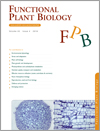
Functional Plant Biology
Volume 45 Number 4 2018
FP17150Plant circadian networks and responses to the environment
Many environmental stresses are periodic and predictable. Plants have adapted to these by temporally organising their stress responses to maximise efficiency and efficacy. We review current evidence for temporal regulation of responses to the environment and environmental impacts on the plant circadian clock. Better understanding of the reciprocal interactions between the plant circadian clock and environmental stresses may aid in identifying mechanisms to improve plant growth and increase food security.
FP17262Phenotyping roots in darkness: disturbance-free root imaging with near infrared illumination
Root properties impact strongly on plant performance, but high-throughput methods for non-invasive and quantitative root trait assessment are rarely available. We developed and tested a root phenotyping concept, which involves NIR imaging of roots grown along surfaces of transparent culture vessels using visible light blocking long pass filters. We reveal the viability of the concept and its suitability for simultaneous root and shoot phenotyping.
FP17262 Abstract | FP17262 Full Text | FP17262PDF (651 KB) | FP17262Supplementary Material (546 KB) Open Access Article
FP17203The involvement of programmed cell death in inflated leaf petiole morphogenesis in Trapa pseudoincisa
The inflated leaf petiole of Trapa pseudoincisa undergoes a developmental process from solid to hollow phase. Schizo-lysigenous aerenchyma was developed via the mechanism of programmed cell death (PCD) during the process of inflated leaf petiole morphogenesis. Thus, a trans-disciplinary systems approach that recognizes the need for integration of cytological and molecular characteristics for identification of aerenchyma type in aquatic plant is required.
FP17095Involvement of signalling molecules NO, H2O2 and H2S in modification of plasma membrane proton pump in cucumber roots subjected to salt or low temperature stress
Cascades by which signalling molecules participate in plant responses to changes in environmental conditions are still under intensive study. Our aim was to explain the role of NO, H2O2 and H2S in adaptation of cucumber seedlings to both salt and low temperature stress. Results show that signalling molecules are important for understanding the mechanisms of modification of the activity of the plasma membrane proton pump, which is a key enzyme in abiotic stress conditions.
FP16378The effect of simulated microgravity on the Brassica napus seedling proteome
Sustaining plant productivity under microgravity conditions is a prerequisite for successful colonisation of space by humans. Therefore, we address the effects of simulated microgravity on seed germination and the first steps of seedling development at the total proteome level. This study complements a large body of transcriptomic data and gives an insight into gravity-related changes in early plant ontogenesis.
FP17056Stomata control is changed in a chlorophyll b-free barley mutant
Chlorophyll b is the major regulator of photosynthetic antennae in land plants. Its absence diminishes light harvesting, photoprotection and ultimately photosynthesis. We show that barley mutants lacking chl b display impaired stomatal control, which can be restored by temporal shading of the plants. Thus the effects of this mutation extend beyond chloroplast metabolism.
FP16393Role of the antioxidant system in the regulation of the chlorophyll biosynthesis pathway in the vascular plant Cucumis sativus
Fine tuning the flow of chlorophyll biosynthesis pathway is crucial for the growth and development of the plants. Antioxidant systems were found to influence this pathway through maintaining the specific concentration of H2O2. This finding provides insights into understanding the antioxidant-mediated regulation of chlorophyll biosynthesis in detail, and will help in the development of oxidative stress-resistant plants.
FP17211Physiological and molecular characterisation for high temperature stress in Lens culinaris
Understanding the mechanism of high-temperature stress (heat) tolerance during the plant reproductive phase is important for developing heat tolerant cultivars in lentil. We found a higher reduction in pollen viability and lower photosynthetic electron transport rate in heat sensitive genotypes and a functional marker amplified only in heat tolerant ones. We conclude that these traits and the associated functional markers will be useful in lentil breeding.



